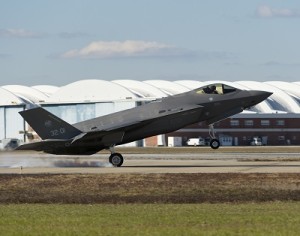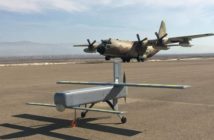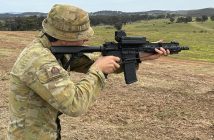
 An Italian Air Force (Aeronautica Militare) F-35A Lightning II aircraft completed very first transatlantic Ocean crossing, arriving at Naval Air Station Patuxent River, Md. from Cameri Air Base, Italy, on February 5 at 2:24 p.m. Eastern time.
An Italian Air Force (Aeronautica Militare) F-35A Lightning II aircraft completed very first transatlantic Ocean crossing, arriving at Naval Air Station Patuxent River, Md. from Cameri Air Base, Italy, on February 5 at 2:24 p.m. Eastern time.
F-35A aircraft AL-1, the first international jet fully built overseas at the Cameri Final Assembly & Check-Out (FACO) facility, was piloted across by the first Italian Air Force F-35 pilot, who completed training at Luke Air Force Base, Arizona, last November and had 50 hours of flight time on the F-35 Lightning II. The aircraft will begin three months of Electromagnetic Environmental Effects (EEE) evaluation and certification while at Naval Air System Command’s Integrated Battlespace Simulation and Test (IBST) facility.

“AL-1 Arrival at NAS Patuxent River, MD on 5 February, 2016. This was the first time a foreign assembled F-35 to land on US soil.”
Aircraft AL-1 will join the F-35 international pilot training fleet at Luke AFB, Arizona in May, the first of five F-35s Italy has committed to the international training fleet there. The next group of Italian pilots will start training at Luke in March with U.S. and other foreign students in the multi-national training program.
The two-phase deployment across the North Atlantic to the U.S. required a total of 11 flight hours, enabled by an Italian Air Force KC-767 aerial refueling tanker, which refueled AL-1 seven times during the ocean crossing. AL-1 departed Cameri, near Milan, on Feb. 4 and flew the first leg of its journey with an Italian tanker and Typhoon escort aircraft to Lajes Air Base, the Azores, Portugal. After remaining overnight, AL-1, the KC-767 tanker, and Typhoon continued onward to Naval Air Station Patuxent River, landing on the afternoon of Feb. 5.
The Italian F-35 pilot, Major Gian Marco D., commented on the successful trans-Atlantic flight and the reliability of the aircraft as he exited the aircraft. “This was the greatest experience of my whole life,” he said. “The aircraft was safe all of the time and able to fulfill the mission. We never had an issue. It is really stable behind the [KC-] 767.”
“The efficiency and reliability of the aircraft has been 100 percent — we had no issues at all,” he added. “This demonstrates the capability of the aircraft itself, of the program. I’m extremely honored to be part of this team, along with my F-35 program teammates who contributed to our success.”
Aircraft AL-1’s arrival in the U.S. demonstrates Italian industry’s capability to build and sustain a fifth generation fighter, an achievement made possible through the close partnership between U.S. and Italian governments and defense leadership.
The Italian FACO — owned by the Italian Ministry of Defense and operated by Finmeccanica-Aeronautics in conjunction with Lockheed Martin Aeronautics — has a current workforce of more than 1,100 skilled Italian personnel engaged in F-35 aircraft and wing production. The Cameri FACO is the heart of the Italian and European F-35 program. It will build all Italian F-35 aircraft, is programmed to build F-35As for the Royal Netherlands Air Force, and retains the capacity to deliver to other European partners in the future.
In December 2014, it was selected by the U.S. Department of Defense as the F-35 Lightning II Heavy Airframe Maintenance, Repair, Overhaul and Upgrade facility for the European region. Finmeccanica-Aeronautics is a strategic co-supplier of F-35A full wing assemblies, which represents one of the largest manufacturing projects for the Italian F-35 program, with 835 full wing assemblies planned.
Italy is now ready to start the next process, the phase in of the Italian fleet, which will see the first F-35 landing at the newly-renovated Amendola Air Base, near Manfredonia, Italy, home of the 32nd Wing before the end of this year.
Three distinct variants of the F-35 will replace the F-16 Fighting Falcon and A/OA-10 Thunderbolt II for the U.S. Air Force, the F/A-18 Hornet for the U.S. Navy, the F/A-18 and AV-8B Harrier for the U.S. Marine Corps, and a variety of fighters for at least ten other countries. Following the U.S. Marine Corps’ July 2015 combat-ready Initial Operational Capability (IOC) declaration, the U.S. Air Force will attain IOC the summer of 2016 and U.S. Navy intends to attain IOC in 2018.





